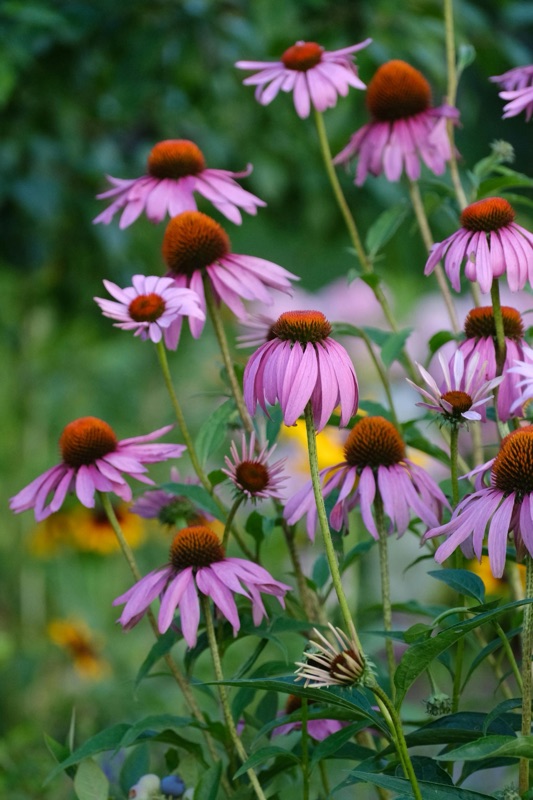Botanical Basics
- Common Name(s): Echinacea, Coneflower, Purple Coneflower
- Folk Name(s): Rudbeckia (old mislabel), Snakeroot, Comb Flower
- Scientific/Latin Name: Echinacea purpurea, Echinacea angustifolia, Echinacea pallida (most common medicinal species)
- Family: Asteraceae (Daisy family)
- Plant Type: Herbaceous perennial
- Botanical Description: Upright plant 2–4 ft tall with rough, lanceolate leaves. Flowers feature purple to pink petals that droop around a spiny, raised orange-brown central cone (name derived from Greek echinos = “hedgehog”). Roots are thick and fibrous.
- Growing Zones/Climate: USDA Zones 3–9
- Best Zones for Growth: Temperate zones with well-drained soils; widely cultivated in gardens across North America
- Habitat & Range: Native to central and eastern North America; grows in prairies, open woods, and dry fields
Cultivation & Harvest
- Soil & Sun Requirements: Prefers full sun and well-drained loam, tolerates poor soils and drought once established
- Propagation: From seed (cold stratification improves germination) or root division in spring/fall
- Companion Planting: Pairs well with bee balm, black-eyed Susan, yarrow, and other pollinator-friendly herbs
- Harvesting Guidelines:
- Roots: Harvest in fall after 3–4 years of growth for maximum potency
- Flowers/Seeds: Harvest when fully open during summer bloom
- Leaves: Gather young leaves in spring and early summer
- Drying/Preservation: Air-dry leaves and flowers in shade; roots dried and stored in airtight containers
Traditional & Historical Use
- Cultural Significance: Used extensively by Native American tribes such as the Sioux, Cheyenne, and Pawnee for snakebites, infections, and wound care
- Traditional Medicine: Valued as a blood purifier, infection fighter, and wound-healer; often chewed fresh root or made into poultices
- Symbolism: Represents health, resilience, and protection against illness
Medicinal & Practical Properties
- Active Constituents: Alkamides, caffeic acid derivatives (echinacoside, chicoric acid), polysaccharides, glycoproteins, flavonoids, essential oils
- Medicinal Uses:
- Immune stimulant (supports body’s defenses against colds, flu, infections)
- Anti-inflammatory and antioxidant
- Topical wound healing (cuts, boils, insect bites)
- May reduce severity/duration of respiratory infections
- Preparation Methods: Teas, tinctures, capsules, poultices, extracts, lozenges, syrups
- Dosage & Guidelines:
- Tea: 1–2 tsp dried root/leaf per cup, 1–3 cups daily
- Tincture: 2–4 mL up to 3 times daily
- Capsules: 300–600 mg standardized extract daily
- Safety/Precautions: Generally safe short-term. Avoid in severe autoimmune disorders or with immunosuppressive drugs. Rare allergies in those sensitive to Asteraceae family.
Magical & Spiritual Properties
- Elemental Association: Fire (healing energy, vitality)
- Planetary/Deity Correspondence: Sun; linked with Apollo (healing and prophecy)
- Magical Correspondences: Strength, healing, protection, abundance, boosting spell effectiveness
- Ritual Use: Added to healing charms, mojo bags, and incense blends; used in offerings for wellness rituals; planted near homes to bring protective energy
- Symbolism in Divination/Dreams: Suggests resilience, healing, or renewal; may signal a time to strengthen boundaries or health practices
Ecological & Culinary Uses
- Pollinator Value: Excellent nectar source for bees, butterflies, and pollinators
- Wildlife Uses: Seeds feed goldfinches and other birds; provides cover for insects
- Culinary Uses: Limited — primarily medicinal; flowers sometimes used in herbal teas
Household/Practical Uses
- Quick Uses: Tincture for immune support, poultice for bites/stings, tea for cold season
- Notable Traits: One of the best-known herbal immune allies; also a resilient garden plant with showy blooms
- Special Notes: Often combined with elderberry, goldenseal, or ginger in immune blends

Supporting Notes
- Chevallier, Andrew. Encyclopedia of Herbal Medicine (2016)
- Grieve, M. A Modern Herbal (1931)
- Foster, Steven. Echinacea: Nature’s Immune Enhancer (1991)
- Duke, James. The Green Pharmacy (1997)
- Barnes, Joanne et al. Herbal Medicines (2007)
No comments:
Post a Comment